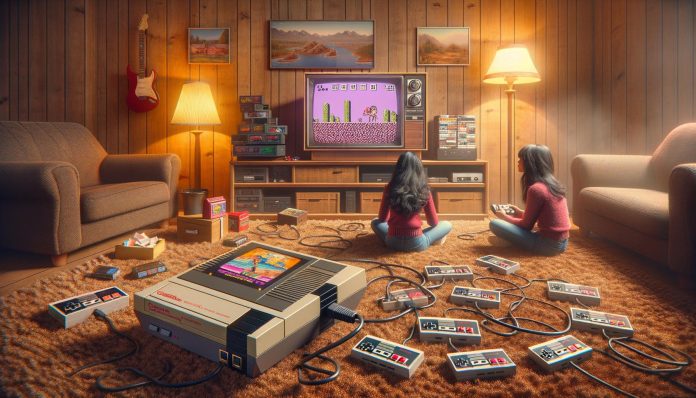The 1980s were a pivotal decade for gaming technology, serving as a bridge between the early days of arcade machines and the emergence of home consoles that would define the future of gaming. As a tech enthusiast and gamer, I find it fascinating to delve into how innovations from this era laid the groundwork for the advanced gaming experiences we enjoy today.
The Rise of Home Consoles
The 1980s witnessed a surge in the popularity of home gaming consoles. While the late 1970s introduced early systems like the Atari 2600, it was in the ’80s that home gaming truly exploded. Companies like Nintendo and Sega emerged as major players, with the release of the Nintendo Entertainment System (NES) in 1985 marking a significant turning point.
The Impact of AI on Gaming
Artificial Intelligence (AI) began to play a more prominent role in game development during this decade. While primitive by today’s standards, early AI algorithms were designed to enhance gameplay by creating challenging opponents and engaging narratives. The introduction of AI not only made games more immersive but also set the stage for future advancements.
For instance, consider the iconic game Pac-Man, released in 1980. The ghosts in Pac-Man exhibited simple AI behaviors that made them unpredictable, adding complexity to the gameplay. This was a significant leap from earlier games that relied on linear scripts.
Advancements in Graphics and Sound
As technology progressed, so did the capabilities of gaming hardware. The 1980s saw significant advancements in graphics and sound, which transformed the gaming experience.
8-bit Graphics to the Rescue
The graphical capabilities of consoles like the NES allowed for vibrant 8-bit graphics, which became iconic in their own right. Titles such as Super Mario Bros. and The Legend of Zelda showcased these graphics, creating a visually appealing experience that captivated players. The 8-bit era had a lasting impact, paving the way for the development of more complex graphics in later decades.
The Sound Revolution
Sound technology also saw remarkable growth during the 1980s. The introduction of synthesizers and improved sound chips allowed for richer audio experiences. Games could now feature catchy tunes and sound effects that complemented the gameplay. For instance, the memorable theme music of Final Fantasy has become a hallmark of gaming history.
Crafting Engaging Narratives
As a writer and editor, I appreciate the art of storytelling in games. Titles like The Legend of Zelda not only provided engaging gameplay but also introduced players to a rich fantasy world filled with lore and adventure. The ability to weave an engaging narrative into gameplay was a significant milestone for the industry.
Copywriting in this era involved creating captivating game manuals, box art, and in-game dialogue that resonated with players. This emphasis on storytelling helped to elevate games from mere entertainment to an art form.
The Evolution of Game Development Tools
As gaming technology evolved, so did the tools available for developers. The 1980s saw the emergence of game engines and programming languages tailored specifically for game development.
Optimizing Game Development
With the rise of home consoles, developers needed to optimize their games for a diverse range of hardware. This led to the development of specialized programming languages and tools that allowed for efficient coding and testing.
I recall discovering how platforms like AlmaLinux provided a stable environment for developers to optimize their applications. While it was not directly related to gaming in the ’80s, the principles of optimizing software for performance have remained relevant in today’s game development landscape.
The Birth of Online Gaming
Although online gaming was in its infancy during the 1980s, the groundwork was laid for future advancements. The introduction of bulletin board systems (BBS) allowed players to connect and share games, fostering a sense of community.
The Early Days of Multiplayer Gaming
As gamers, we may take for granted the multiplayer experiences we have today. However, the 1980s introduced us to the idea of connecting with others through games. The advent of titles like MUD (Multi-User Dungeon) in 1978 opened the door for text-based online gaming, leading to the eventual rise of graphical MMOs in later years.
Conclusion
Reflecting on the 1980s gaming tech revolution, I am continually amazed by how far we have come. The innovations in AI, graphics, sound, and storytelling during this decade laid the foundation for the gaming experiences we cherish today.
As tech enthusiasts and gamers, we should appreciate the milestones from this era and consider how they influence modern gaming. Whether it’s the optimization techniques that developers use today or the narratives that captivate us, the spirit of the 1980s continues to resonate in the gaming world.
<iframe width="560" height="315" src="https://www.youtube.com/embed/2vtrCZf4S_Y?si=vFid6eqEqfQYMC05" title="YouTube video player" frameborder="0" allow="accelerometer; autoplay; clipboard-write; encrypted-media; gyroscope; picture-in-picture; web-share" referrerpolicy="strict-origin-when-cross-origin" allowfullscreen></iframe>




.jpg?w=100&resize=100,70&ssl=1)
